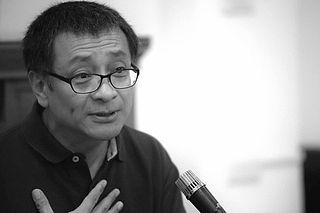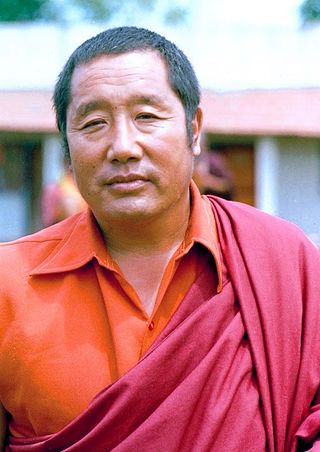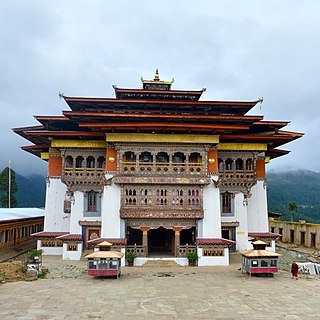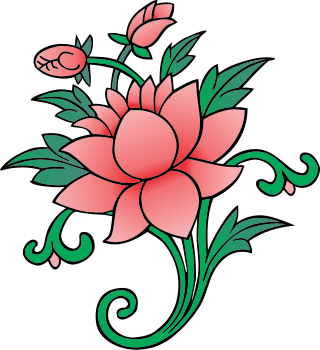
The Gyalwa Karmapa is the head of the Karma Kagyu, the largest sub-school of the Kagyu school, itself one of the four major schools of Tibetan Buddhism. The Karmapa was Tibet's first consciously incarnating lama.

Padmasambhava, also known as Guru Rinpoche and the Lotus from Oḍḍiyāna, was a tantric Buddhist Vajra master from medieval India who taught Vajrayana in Tibet. According to some early Tibetan sources like the Testament of Ba, he came to Tibet in the 8th century and helped construct Samye Monastery, the first Buddhist monastery in Tibet. However, little is known about the actual historical figure other than his ties to Vajrayana and Indian Buddhism.

Jamyang Khyentse Wangpo, also known by his tertön title, Pema Ösel Dongak Lingpa, was a teacher, scholar and tertön of 19th-century Tibet. He was a leading figure in the Rimé movement.

The 7th Dzogchen Ponlop is an abbot of Dzogchen Monastery, founder and spiritual director of Nalandabodhi, founder of Nītārtha Institute for Higher Buddhist Studies, a leading Tibetan Buddhist scholar, and a meditation master. He is one of the highest tülkus in the Nyingma lineage and an accomplished Karma Kagyu lineage holder.

Kyabje Dudjom Rinpoche Jigdral Yeshe Dorje was known simply as Dudjom Rinpoche. He is considered by many Tibetan Buddhists to be from an important Tulku lineage of Terton Dudul Dorje (1615-1672), and was recognized as the incarnation of Terton Dudjom Lingpa (1835-1904), a renowned treasure revealer. He was a direct incarnation of both Padmasambhava and Dudjom Lingpa. He was a Nyingma householder, a yogi, and a Vajrayana and Dzogchen master. According to his secretary Khenpo Tsewang Dongyal and many others, he was revered as "His Holiness" (Kyabje) and as a "Master of Masters".

Chatral Sangye Dorje Rinpoche was a Tibetan Dzogchen master and a reclusive ngagpa yogi, known for his great realization and strict discipline. Chatral Sangye Dorje was a disciple of Khenpo Ngawang Pelzang and was widely regarded as one of the most highly realized Dzogchen yogis. In addition to his relationship with Khenpo Ngagchung, Chatral Sangye Dorje also studied with some of the last century's most renowned masters, including Dudjom Jigdral Yeshe Dorje, Dzongsar Khyentse Chökyi Lodrö, and the famed Kunzang Dekyong Wangmo. Chatral Sangye Dorje was one of the primary lineage holders of the Longchen Nyingthig, and in particular the lineage that descends through Jigme Lingpa's heart son Jigme Gyalwe Nyugu and then on to Patrul Rinpoche.
Longdé is the name of one of three scriptural divisions within Dzogchen, which is itself the pinnacle of the ninefold division of practice according to the Nyingma school of Tibetan Buddhism.

Kyabjé Drubwang Padma Norbu Rinpoche, 1932 – 27 March 2009, was the 11th throneholder of the Palyul Lineage of the Nyingma school of Tibetan Buddhism, and said to be an incarnation of Vimalamitra. He was widely renowned in the Tibetan Buddhist world as a master of Dzogchen. He was one of a very few teachers left from his generation who received all his training in Tibet under the guidance of what Tibetan Buddhists consider to be fully enlightened teachers.

Kyabje Dungse Thinley Norbu Rinpoche was a major modern teacher in the Nyingma lineage of Tibetan Buddhism, and patron of the Vajrayana Foundation. He was the eldest son of Dudjom Rinpoche, the former head of the Nyingma lineages, and also the father of Dzongsar Jamyang Khyentse Rinpoche and Dungse Garab Rinpoche. His association with the Dudjom Lineage is a long one: he is held to be the incarnation of Tulku Drime Oser, who was one of seven sons of Dudjom Lingpa. He also was considered to be an emanation of Longchen Rabjam, the great 14th-century Nyingma scholar and siddha who composed the Seven Treasuries. He died in California on December 26, 2011, according to the Tibetan Buddhist Lunar Calendar the 2nd day of the 11th month of the Iron Rabbit year. His cremation was held in a public buddhist cremation ceremony in Paro, Bhutan on March 3, 2012, which was attended by several thousand people, including some of Bhutan's royal family.
In Tibetan Buddhism, there is a lama named the eleventh Mindrolling Trichen, Trichen Jurme Kunzang Wangyal Standard Tibetan: འགྱུར་མེད་ཀུན་བཟང་དབང་རྒྱལ་. This lama is lama of the Nyingma-school, and had been responsible for the administrative affairs for the school in exile as the ceremonial head of the lineage. He is generally regarded as one of the greatest Tibetan masters.

Tertön Sogyal Lerab Lingpa was a Tibetan Buddhist tertön and a teacher of the Thirteenth Dalai Lama.
Dorjidak Gompa or Tupten Dorjidak Dorjé Drak Éwam Chokgar is a Tibetan Buddhist monastery and one of the Nyingma school's "Six Mother Monasteries" in Tibet. It is located in the Lhoka (Shannan) Prefecture in the south of the Tibet Autonomous Region, older southeastern Ü-Tsang.
Khunu Lama Tenzin Gyaltsen, 1894–1977, known also as Negi Lama Tenzin Gyaltsen, Tenzin Gyaltsen, and various other names like Kunu Rinpoche, Kunu Lama and Negi Lama, was born in 1894 in the village of Sunam which lies in the Kinnaur district of India in the western Himalayas. He passed away at the age of 82 at Shashur Monastery in the Lahaul and Spiti district of Himachel Pradesh on February 23, 1977, while teaching the final page of Gampopa's Jewel Ornament of Liberation. Khunu Rinpoche was not officially recognized as a tulku, nor was he an ordained Buddhist monk, but a layman who had taken lay practitioner's vows before becoming a Tibetan Buddhist master.

Trülku Drakpa Gyeltsen (1619–1656) was an important Gelugpa lama and a contemporary of the 5th Dalai Lama (1617–1682). His Seat was the upper residence of Drepung Monastery, a famous Gelug gompa located near Lhasa.

Gangteng Monastery, also known as Gangtey Gonpa or Gangtey Monastery, is a monastery of Nyingmapa school of Tibetan Buddhism, the main seat of the Pema Lingpa tradition, located in the Wangdue Phodrang District in central Bhutan. The monastery, also known by the Gangten village that surrounds it, is in the Phobjikha Valley where winter visitors – the black-necked cranes – visit central Bhutan to roost, circling the monastery three times on arrival and repeating this circling when returning to Tibet. The monastery's history traces to the early 17th century and back to the prophecies made by the terton Pema Lingpa in the late 15th century.

Jonê County is a county in the Gannan Tibetan Autonomous Prefecture, Gansu Province, China. Its postal code is 747600. Its area is 4,954 km2 (1,913 sq mi), and its population is over 100,000 people. It is administered from Liulin.

Dagpo Kagyu Tibetan: དྭགས་པོ་བཀའ་བརྒྱུད, Wylie: dwags po bka' brgyud encompasses the branches of the Kagyu school of Tibetan Buddhism that trace their lineage back through Gampopa (1079-1153), who was also known as Dagpo Lhaje "the Physician from Dagpo" and Nyamed Dakpo Rinpoche "Incomparable Precious One from Dagpo". All the institutional branches of the Kagyu tradition of Tibetan Buddhism surviving today, including the Drikung Kagyu, the Drukpa Lineage and the Karma Kagyu, are branches of the Dagpo Kagyu.
Duldzin Dragpa Gyaltsen (1374-1434), the first Kyorlung Ngari Tulku, was one of the principal disciples of Je Tsongkhapa, the founder of the Gelugpa school of Tibetan Buddhism.
The Phagmo Drupa Kagyu or Phagdru Kagyu (ཕག་གྲུ་བཀའ་བརྒྱུད) is a subschool of the Tibetan Kagyu school.


















